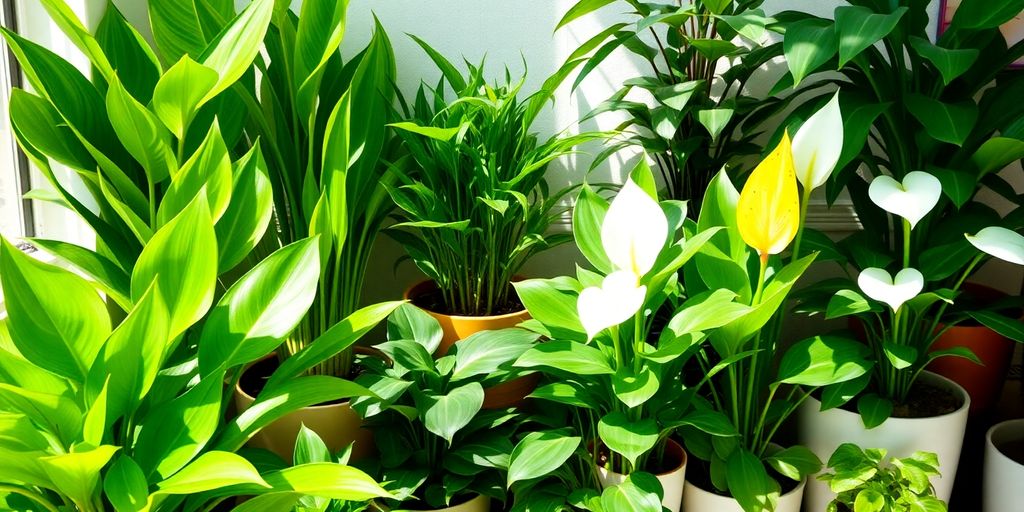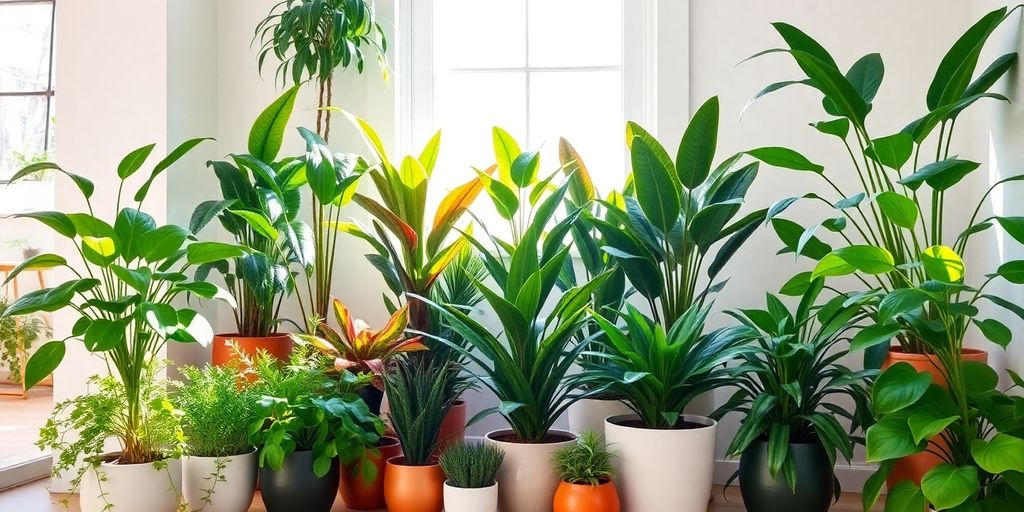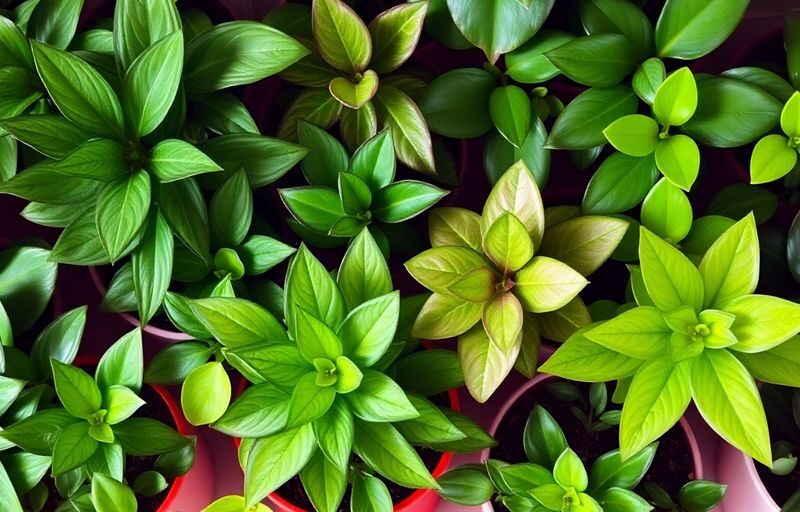If you’re looking to bring some greenery into your home without the hassle of constant care, you’re in luck! There are plenty of indoor plants that thrive on neglect and still look great. From low-light options to drought-tolerant varieties, this guide will help you find the best low maintenance indoor plants that fit your lifestyle. Let’s explore some fantastic choices that can brighten up your space with minimal effort!
Key Takeaways
- Choose plants based on your home’s light and humidity levels.
- Low-light plants like ZZ and Pothos are perfect for dim spaces.
- Drought-tolerant varieties like Aloe and Jade are great for forgetful waterers.
- Air-purifying plants such as Peace Lily help improve indoor air quality.
- Unique options like Air Plants and Orchids add character without demanding much care.
Choosing The Right Indoor Environment
Before you even think about bringing a plant home, it’s important to consider the environment you’re offering. Not all plants are created equal, and what thrives in one home might struggle in another. It’s all about understanding your space and matching it with the right plant.
Assessing Light Conditions
First things first: how much light does your space actually get? This is probably the most important factor. Observe how sunlight moves through your rooms during the day. Is it direct, intense light, or soft, indirect light? Some plants need a ton of sun, while others prefer shade. South-facing windows usually offer the most light, while north-facing windows offer the least. East and west-facing windows are somewhere in between. If you’re unsure, a light meter can help you get a more accurate reading. You can find low-light indoor plants that will thrive in darker spaces.
Understanding Humidity Levels
Next up: humidity. Some plants, especially those from tropical regions, love humidity. Others, not so much. If your home is dry (especially during winter), you might need to take steps to increase humidity around your plants. Here are a few ways to do that:
- Group plants together: Plants release moisture through transpiration, so grouping them creates a more humid microclimate.
- Use a humidifier: A humidifier can add moisture to the air, benefiting both your plants and your skin.
- Place plants on a pebble tray: Fill a tray with pebbles, add water to just below the top of the pebbles, and place your plants on top. As the water evaporates, it increases humidity around the plants.
Evaluating Temperature Ranges
Finally, consider the temperature in your home. Most houseplants prefer temperatures between 65°F and 75°F (18°C and 24°C). Avoid placing plants near drafts, heating vents, or air conditioning units, as these can cause temperature fluctuations that stress plants. Also, keep in mind that temperatures near windows can be significantly colder in winter, so you might need to move plants away from windowsills during cold snaps.
Creating the right environment is half the battle. By taking the time to assess your space and understand your plants’ needs, you’ll be well on your way to a thriving indoor garden.
Top Picks For Low Light Spaces
So, you’ve got a spot in your home that’s a little on the dim side? No problem! Plenty of plants actually prefer lower light conditions. You don’t need a sun-drenched window to bring some greenery into your life. These plants are super easy to care for and thrive in those shadier corners.
ZZ Plant
The ZZ plant is a real winner if you tend to forget about watering. It can handle drought like a champ and doesn’t need much light at all. Seriously, you can almost neglect it, and it’ll still look great. The ZZ plant is also known as Zamioculcas zamiifolia, and it’s a great choice for beginners. Its glossy, dark green leaves add a touch of elegance to any room. Just be careful if you have pets or small children, as it can be toxic if ingested.
Pothos
Pothos, sometimes called Devil’s Ivy, is another super versatile plant. It trails beautifully, so it’s perfect for hanging baskets or shelves. It tolerates low light well, though it will grow faster and fuller with a bit more light. You can even propagate pothos cuttings in water, making it easy to create new plants from the original plant. Pothos comes in several varieties, with different leaf colors and patterns, so you can find one that fits your style.
Snake Plant
Snake plants are practically indestructible. They can survive in almost any light condition and don’t need frequent watering. They’re also great air purifiers, so they help clean the air in your home. Snake plants, also known as Sansevieria trifasciata, have striking, upright leaves that add a modern touch to any space. They’re slow growers, so you won’t have to worry about them outgrowing their pots too quickly.
These low-light champions are perfect for adding a touch of green to your home without requiring a lot of fuss. They’re ideal for beginners or anyone who wants to enjoy the beauty of plants without the high maintenance.
Drought-Tolerant Indoor Plants
Okay, so you’re the type who forgets to water plants? No shame! Some plants actually prefer you neglect them a little. These drought-tolerant champions are perfect for busy folks or anyone who’s a bit forgetful. They store water in their leaves, stems, or roots, so they can handle dry spells like pros. Let’s dive into some of the best options.
Aloe Vera
Everyone knows aloe, right? It’s not just for sunburns. Aloe vera is a super easy succulent to grow indoors. It loves bright, indirect light and well-draining soil. Seriously, underwatering is way better than overwatering with these guys. Plus, you’ve got a handy first-aid kit right on your windowsill. I’ve had one for years, and it’s still kicking, even with my questionable watering habits. It’s a great starter houseplant.
Jade Plant
Jade plants are like the bonsai of the succulent world. They’re slow-growing, sturdy, and can live for ages. They like bright light and infrequent watering. Let the soil dry out completely between waterings. Seriously, completely. They’re also pretty forgiving if you forget for a week or two. I’ve seen some massive jade plants that are decades old, so you know they’re tough. They’re great for adding a bit of zen to your space. Plus, they’re supposed to bring good luck, so that’s a bonus.
Echeveria
Echeverias are those rosette-shaped succulents that come in all sorts of colors and textures. They’re super trendy right now, and for good reason. They’re easy to care for and look amazing. They need bright light and well-draining soil. Water them when the soil is completely dry. They’re perfect for small pots and can add a pop of color to any room. I’ve got a few different varieties, and they’re all thriving, even though I sometimes forget they exist. They’re like the low-maintenance divas of the plant world.
I’ve found that using terracotta pots really helps with drought-tolerant plants. The terracotta wicks away excess moisture, which prevents root rot. It’s a simple trick, but it makes a big difference.
Here’s a quick guide to watering:
- Check the soil moisture before watering.
- Water deeply when the soil is dry.
- Avoid getting water on the leaves.
- Use well-draining soil.
Air Purifying Indoor Plants

Beyond just looking nice, some houseplants are like little air filters for your home. They can remove toxins and help you breathe easier. It’s pretty cool how they do that!
Peace Lily
Peace lilies are gorgeous, with their elegant white flowers, and they’re known for their air-purifying abilities. They can help remove mold spores, which is great for allergy sufferers. Just be aware that they are toxic to pets, so keep them out of reach. They prefer shade, so they’re great for rooms that don’t get a ton of light. Make sure you provide proper care for your peace lily.
Spider Plant
Spider plants are super easy to propagate, making them a great choice for beginners. They’re also champions at removing formaldehyde from the air. Plus, they produce little “spiderettes” that you can easily repot to create new plants. They like bright, indirect light and moderate watering. They’re also non-toxic to pets, which is a big plus!
Boston Fern
Boston ferns are known for their lush, feathery fronds, and they’re excellent at removing pollutants like formaldehyde and xylene from the air. They do require a bit more humidity than some other houseplants, so misting them regularly or placing them in a bathroom is a good idea. They also prefer indirect light and consistently moist soil. They can be a bit finicky, but the air-purifying benefits are worth it.
Having plants around the house is more than just decoration. They can actually improve your indoor air quality, making your home a healthier and more pleasant place to be. It’s a win-win!
Unique And Exotic Low Maintenance Plants
Let’s move beyond the usual suspects and explore some truly unique and exotic plants that don’t demand constant attention. These selections add a touch of the extraordinary to your indoor garden without turning you into a full-time plant caretaker. These plants offer a blend of visual interest and easy care, perfect for those seeking something a little different.
Air Plants
Air plants (Tillandsia) are epiphytes, meaning they don’t need soil to grow! They absorb moisture and nutrients from the air. This makes them incredibly versatile and easy to display. Just soak them in water for 15-30 minutes every week or two, let them dry upside down to prevent rotting, and provide them with bright, indirect light. They’re perfect for terrariums, hanging displays, or even glued to pieces of driftwood. You can find a variety of low-maintenance plants that are easy to care for.
Orchids
Orchids often have a reputation for being fussy, but certain varieties, like Phalaenopsis (moth orchids), are surprisingly low-maintenance. They thrive on neglect, preferring to dry out completely between waterings. Overwatering is their biggest enemy! Place them in bright, indirect light, and they’ll reward you with stunning, long-lasting blooms. Repotting is only needed every year or two, using a special orchid mix. Here’s a quick guide:
- Water every 1-2 weeks, allowing the potting mix to dry out completely.
- Provide bright, indirect light.
- Fertilize sparingly during the growing season.
Fiddle Leaf Fig
The Fiddle Leaf Fig (Ficus lyrata) has gained popularity for its large, sculptural leaves. While they can be a bit finicky when first introduced to a new environment, once they acclimate, they’re relatively low-maintenance. They need bright, indirect light and consistent watering, allowing the top inch of soil to dry out between waterings. Avoid sudden changes in temperature or location, as this can cause them to drop their leaves. They can be susceptible to root rot, so ensure proper drainage.
Fiddle Leaf Figs are known to be dramatic, but with a little patience and the right conditions, they can thrive indoors. Consistent care is key to keeping them happy and healthy.
Caring For Your Indoor Plants
So, you’ve got your plants, and they’re looking pretty good. Now what? Keeping them alive and thriving is the next step. It’s not rocket science, but a little attention goes a long way. Think of it like having a pet – they need food, water, and a little bit of love.
Watering Tips
Watering is probably the trickiest part. Overwatering is a much bigger problem than underwatering for most indoor plants. I usually stick my finger about an inch into the soil to check if it’s dry before watering. If it feels moist, hold off. Also, make sure your pots have drainage holes! Nobody likes soggy roots.
- Water deeply when you do water, until it drains out the bottom.
- Use room-temperature water – cold water can shock some plants.
- Consider the season – plants usually need less water in the winter.
Fertilizing Guidelines
Plants need food, just like us! But don’t go overboard. I usually fertilize my plants every month or two during the growing season (spring and summer). In the fall and winter, they don’t need as much.
I use a balanced liquid fertilizer diluted to half strength. It’s better to under-fertilize than over-fertilize, as too much fertilizer can burn the roots. Look for a fertilizer specifically made for houseplants.
Pruning and Maintenance
Pruning might sound scary, but it’s really just about keeping your plants looking their best. Snip off any dead or yellowing leaves. This not only makes the plant look nicer but also encourages new growth. Also, wipe down the leaves occasionally to remove dust – this helps them absorb sunlight better.
- Use clean, sharp scissors or pruning shears.
- Remove any dead or diseased foliage promptly.
- Pinch back leggy growth to encourage bushier plants.
Creating A Plant-Friendly Home

It’s more than just buying a plant; it’s about setting up an environment where your green friends can truly thrive. Think of it as curating a living space that celebrates nature, not just tolerates it. Let’s explore how to make your home a haven for your indoor plants.
Choosing The Right Pots
Selecting the correct pot is more than just aesthetics; it’s about the plant’s health. Consider the material – terracotta pots are porous, allowing for better air circulation and preventing waterlogging, which is great for plants that don’t like sitting in wet soil. Plastic pots, on the other hand, retain moisture longer, which can be beneficial for plants that need consistent hydration. Size matters too! A pot that’s too small will restrict root growth, while one that’s too large can lead to excess moisture retention and root rot. Don’t forget drainage! Make sure your pots have drainage holes to prevent water from accumulating at the bottom. For renter-friendly plant-filled home, consider lightweight options.
Arranging Plants For Aesthetic Appeal
Plant arrangement is where you can really let your creativity shine. Grouping plants with similar needs together not only makes care easier but also creates a visually appealing display. Consider varying heights and textures to add depth and interest. Place taller plants in the back and shorter, trailing plants in the front to create a layered effect. Use plant stands or shelves to elevate some plants and add visual interest. Don’t be afraid to experiment with different arrangements until you find one that you love. Remember, the goal is to create a harmonious and balanced display that complements your existing decor.
Incorporating Plants Into Your Decor
Plants can be more than just decorative accents; they can be integral parts of your home’s design. Consider using plants to soften harsh lines or add a pop of color to a neutral space.Trailing plants can cascade down shelves or hang from macrame planters, adding a touch of whimsy and movement. Larger plants can serve as focal points in a room, drawing the eye and creating a sense of drama. Don’t be afraid to mix and match different types of plants to create a unique and personalized look. Think about using plants to define spaces or create a sense of privacy. A row of tall plants can act as a natural room divider, separating a living area from a dining area, for example.
Integrating plants into your decor is about finding the right balance between aesthetics and functionality. Choose plants that complement your style and enhance your living space, while also providing the care and attention they need to thrive. With a little creativity and planning, you can transform your home into a lush and inviting oasis.
Here are some ideas to get you started:
- Use plants to frame a window or doorway.
- Create a green wall using climbing plants or vertical planters.
- Place a large plant in an empty corner to fill the space and add visual interest.
Final Thoughts on Low Maintenance Indoor Plants
So there you have it! Picking the right low-maintenance indoor plants can really brighten up your space without a ton of effort. Whether you go for a pothos, ZZ plant, or snake plant, these greens are perfect for anyone who might not have the best track record with plants. They’re forgiving, easy to care for, and can thrive in various light conditions. Plus, they add a nice touch to your home and can even help clean the air. So, if you’re looking to add some life to your home without the stress, these plants are a great choice. Happy planting!
Frequently Asked Questions
What are some easy indoor plants to care for?
Some of the easiest indoor plants include pothos, snake plants, and ZZ plants. They can survive in different light conditions and don’t need much water.
How often should I water my indoor plants?
Most indoor plants need water about once a week, but it can vary. Always check the soil first; if it’s dry an inch down, it’s time to water.
Can indoor plants help clean the air?
It’s best to use pots with drainage holes to prevent overwatering. Make sure the pots are the right size for the plants.
How can I make my indoor plants grow better?
Give your plants the right amount of light, water them properly, and use fertilizer during the growing season to help them thrive.
Are there any indoor plants that are safe for pets?
Yes, some pet-friendly plants include spider plants, Boston ferns, and certain types of bamboo. Always check if a plant is safe before bringing it home.





